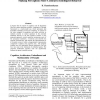42 search results - page 7 / 9 » Formalizing Design Spaces: Implicit Invocation Mechanisms |
HPCA
2003
IEEE
14 years 7 months ago
2003
IEEE
Due to cost, time, and flexibility constraints, simulators are often used to explore the design space when developing a new processor architecture, as well as when evaluating the ...
HICSS
2003
IEEE
14 years 20 days ago
2003
IEEE
Todays, we assist to the explosive development of mobile computing devices like PDAs and cell-phones, the integration of embedded intelligence (like Web server) in more and more c...
AAAI
2006
13 years 8 months ago
2006
I propose that the notion of cognitive state be broadened from the current predicate-symbolic, Language-of-Thought framework to a multi-modal one, where perception and kinesthetic...
CORR
2008
Springer
13 years 7 months ago
2008
Springer
Scheduling problems are generally NP-hard combinatorial problems, and a lot of research has been done to solve these problems heuristically. However, most of the previous approach...
CORR
2011
Springer
13 years 2 months ago
2011
Springer
We consider the problem of human-assisted graph search: given a directed acyclic graph with some (unknown) target node(s), we consider the problem of finding the target node(s) b...



